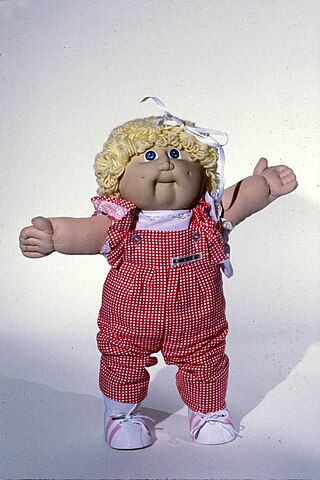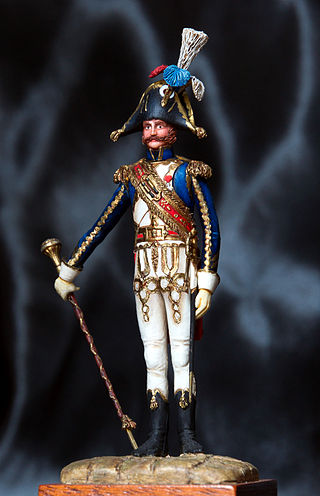Related Research Articles

A fishing rod is a long, thin rod used by anglers to catch fish by manipulating a line ending in a hook. At its most basic form, a fishing rod is a straight rigid stick/pole with a line attached to one end ; however, modern rods are usually elastic and generally have the line stored in a reel mounted at the rod handle, which is hand-cranked and controls the line retrieval, as well as numerous line-restricting rings that distribute bending stress along the rod and help dampening down/prevent line whipping and entanglement. To better entice fish, baits or lures are dressed onto the one or more hooks attached to the line, and a bite indicator is used, some of which might be incorporated as part of the rod itself.

Cabbage Kids are a line of cloth dolls with plastic heads first produced by Coleco Industries in 1982. They were inspired by the Little People soft sculptured dolls sold by Xavier Roberts as collectibles. The brand was renamed 'Cabbage Kids' by Roger L. Schlaifer when he acquired the exclusive worldwide licensing rights in 1982.

A toy or plaything is an object that is used primarily to provide entertainment. Simple examples include toy blocks, board games, and dolls. Toys are often designed for use by children, although many are designed specifically for adults and pets. Toys can provide utilitarian benefits, including physical exercise, cultural awareness, or academic education. Additionally, utilitarian objects, especially those which are no longer needed for their original purpose, can be used as toys. Examples include children building a fort with empty cereal boxes and tissue paper spools, or a toddler playing with a broken TV remote control. The term "toy" can also be used to refer to utilitarian objects purchased for enjoyment rather than need, or for expensive necessities for which a large fraction of the cost represents its ability to provide enjoyment to the owner, such as luxury cars, high-end motorcycles, gaming computers, and flagship smartphones.

The toy piano, also known as the kinderklavier, is a small piano-like musical instrument. Most modern toy pianos use round metal rods, as opposed to strings in a regular piano, to produce sound. The U.S. Library of Congress recognizes the toy piano as a unique instrument with the subject designation, Toy Piano Scores: M175 T69. The most famous example of a dedicated composition for the instrument is the "Suite for Toy Piano" (1948) by John Cage.

An action figure is a poseable character model figure made most commonly of plastic, and often based upon characters from a film, comic book, military, video game or television program; fictional or historical. These figures are usually marketed toward boys and adult collectors. The term was coined by Hasbro in 1964 to market G.I. Joe to boys.

A surfboard is a narrow plank used in surfing. Surfboards are relatively light, but are strong enough to support an individual standing on them while riding an ocean wave. They were invented in ancient Hawaii, where they were known as papa he'e nalu in the Hawaiian language, and were usually made of wood from local trees, such as koa. They were often over 460 cm (15 ft) in length and extremely heavy. Major advances over the years include the addition of one or more fins (skegs) on the bottom rear of the board to improve directional stability, and numerous improvements in materials and shape.

Miniature wargaming is a form of wargaming in which military units are represented by miniature physical models on a model battlefield. The use of physical models to represent military units is in contrast to other tabletop wargames that use abstract pieces such as counters or blocks, or computer wargames which use virtual models. The primary benefit of using models is aesthetics, though in certain wargames the size and shape of the models can have practical consequences on how the match plays out.

A mattress is a large, usually rectangular pad for supporting a lying person. It is designed to be used as a bed, or on a bed frame as part of a bed. Mattresses may consist of a quilted or similarly fastened case, usually of heavy cloth, containing materials such as hair, straw, cotton, foam rubber, or a framework of metal springs. Mattresses may also be filled with air or water.

Nerf is a toy brand formed by Parker Brothers and currently owned by Hasbro. Most of the toys are a variety of foam-based weaponry, with other Nerf products including balls for sports such as American football, basketball, and baseball. Their best known toys are their dart guns that shoot ammunition made from "Nerf foam". Their primary slogan, first introduced in the 1990s, is "It's Nerf or Nothin'!". Annual revenues under the Nerf brand are approximately US$400 million.

A model figure is a scale model representing a human, monster or other creature. Human figures may be either a generic figure of a type, a historical personage, or a fictional character.

A die-cast toy is a toy or a collectible model produced by using the die-casting method of putting molten lead, zinc alloy or plastic in a mold to produce a particular shape. Such toys are made of metal, with plastic, rubber, glass, or other machined metal parts. Wholly plastic toys are made by a similar process of injection molding, but the two methods are distinct because of the properties of the materials.

Majorette is a French toy manufacturer which mostly produces small Die-cast scale model cars, commercial vehicles, aircraft, and other vehicles, particularly in 1:64 scale. This is a normal 2.5–3 in (64–76 mm) size, thus Majorette has sometimes been called "the Matchbox of France". Traditionally, production was centered in the urban area of Lyon, but models are now made in Thailand.
Barrel of Monkeys is a toy game released by Lakeside Toys in 1965. It was created by Leonard Marks and Milton Dinhofer in 1961, and in 1964, Herman Kesler partnered to sell it to Lakeside Toys. Lakeside Toys released it in 1965 and today it is produced by the Milton Bradley Company within the Hasbro corporation. Milton Bradley's editions consist of a toy barrel in either blue, yellow, red, purple, orange, gray or green. The barrel contains 13 monkeys but can hold 24, their color usually corresponding to the barrel's color. The instructions state, "Dump monkeys onto table. Pick up one monkey by an arm. Hook other arm through a second monkey's arm. Continue making a chain. Your turn is over when a monkey is dropped." In addition to these basic instructions, the barrel also contains instructions for playing alone or with two or more players.
Art toys, also called designer toys, are toys and collectibles created by artists and designers that are either self-produced or made by small, independent toy companies, typically in very limited editions. Artists use a variety of materials, such as ABS plastic, vinyl, wood, metal, latex, plush, and resin. Creators often have backgrounds in graphic design, illustration, or fine art, but many accomplished toy artists are self-taught. The first art toys appeared in the 1990s in Hong Kong and Japan. By the early 2000s, the majority of art toys were based upon characters created by popular Lowbrow artists, linking the two movements.

A vibrator, sometimes described as a massager, is a sex toy that is used on the body to produce pleasurable sexual stimulation. There are many different shapes and models of vibrators. Most modern vibrators contain an electric-powered device which pulsates or throbs. Vibrators can be used for both solo play and partnered play by one or more people. Devices exist to be used by couples to stimulate the genitals of both partners. They can be applied to erogenous zones, such as the clitoris, the vulva or vagina, penis, scrotum or anus, for sexual stimulation, for the release of sexual frustration and to achieve orgasm. Vibrators may be recommended by sex therapists for women who have difficulty reaching orgasm through masturbation or intercourse.

Educational toys are objects of play, generally designed for children, which are expected to stimulate learning. They are often intended to meet an educational purpose such as helping a child develop a particular skill or teaching a child about a particular subject. They often simplify, miniaturize, or even model activities and objects used by adults.
Aquapets are interactive, electronic toys that were introduced in the US in 2004 by Wild Planet. They consist of a transparent, water-filled case housing a thumb-sized figure, and a base with a microchip, microphone, and speaker to register and respond to sounds made by kids or by other Aquapets. Each character has its own look, sounds and songs and responds with movement and melody. The more a child plays with their Aquapets, the more songs they will perform and the livelier they will become.

A Nerf Blaster is a toy gun made by Hasbro that fires foam darts, arrows, discs, or foam balls. The term "Nerf gun" or the more common term “nerf blaster” are often used to describe the toy. Nerf blasters are manufactured in multiple forms; the first Nerf blasters emerged in the late 1980s with the release of the Nerf Blast-a-Ball and Arrowstorm. Today, Hasbro has produced over twenty unique lines of Nerf-brand blasters, which each line centered around a particular theme or type of ammunition. Moreover, Hasbro has also produced Nerf blasters based around specific franchises, including Marvel Comics, Star Wars, G.I. Joe, Fortnite, Transformers, Overwatch, Halo Infinite, and Roblox. Nerf blasters are available in several international marketplaces, although some blasters have their names changed or are not sold in certain countries due to laws surrounding toy safety franchises.

Traditional Mexican handcrafted toys are those made by artisans rather than manufactured in factories. The history of Mexican toys extends as far back as the Mesoamerican era, but many of the toys date to the colonial period. Many of these were introduced as teaching tools by evangelists, and were associated with certain festivals and holidays. These toys vary widely, including cup and ball, lotería, dolls, miniature people, animals and objects, tops and more—made of many materials, including wood, metal, cloth, corn husks, ceramic, and glass. These toys remained popular throughout Mexico until the mid-20th century, when commercially made, mostly plastic toys became widely available. Because of the advertising commercial toys receive and because they are cheaper, most traditional toys that are sold as handcrafts, principally to tourists and collectors.
Rainbow Loom is a plastic tool used to weave colorful rubber and plastic bands into decorative items such as bracelets and charms. It was invented in 2010 by Cheong Choon Ng in Novi, Michigan.
References
- ↑ "Toobers & Zots". Little Kids. Retrieved 2011-06-16.